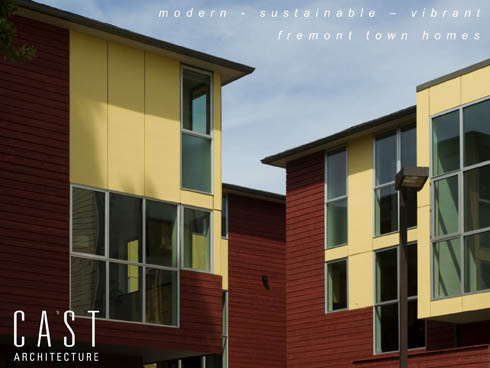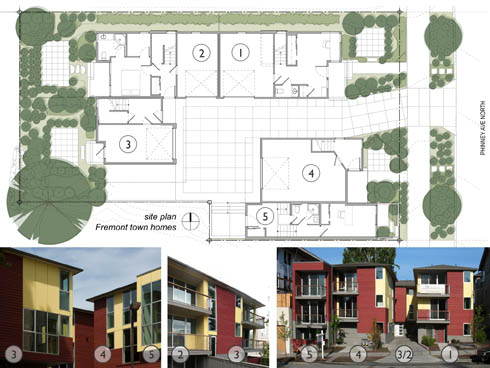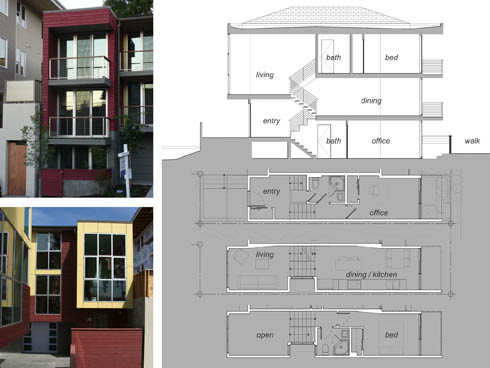IN-FREMONT 10X10X10
The 10x10x10 is an event put on by the Northwest EcoBuilding Guild annually to highlight regional sustainably oriented projects each year. Â The name derives from the fact that they showcase 10 projects, and give each presenter 10 minutes to talk about 10 slides. Â This year CAST was selected to be one of the presenters for our work on in-fremont, a series of 5 town homes designed for 5 star BuiltGreen certification. The event was held at the Gates auditorium, at the Seattle Public Library last Friday. There were some great projects discussed - I especially enjoyed Christina Bollo's talk from SMR on Kenyon House a LEED platinum affordable housing project. Â Since I have all the material handy I thought I would post the slides from my talk, as well as a quick transcript, which steps through some of the concepts, and techniques we were working on with the in-fremont project.

SLIDE 1 - Intro:
- In-fremont is a set of 5 town homes finished in the spring this year – which was not exactly great timing!
- But we had a client who was excited to explore what we could do in terms of a high quality sustainably minded project
- In 2007 we received a Built Green grant in their multifamily category, which was a great help in trying to push a project like this forward.

SLIDE 2 - Quick orientation:
- Location: just north of 36th in Fremont on phinney – extremely pedestrian oriented location.
- 5 units counterclockwise. Goal was to Break out of the typical 4 pack plan you see all over.
- This is a bit of an atypical site having a 10’ wide x 40’ deep slice of commercial zoned C1-40 in an otherwise typical L-2 lot.
- Since we could not span across the zoning line with this unit, it provided a unique constraint as well as a great tie in to the 10x10x10 …
- So in addition to the 10 presenters and 10 slides and 10 minutes, i‘m going to add 10 feet. That is the outside to outside dimension of unit 5 and good segway for talking about sustainability and scale.

SLIDE 3 - unit 5:
- Unit 5 ended up being a 950 sqft 2br 2 bath
- Quantity is intrinsically linked to sustainability - you can do as much advanced framing, and responsible specifications as possible, in the end the way to leverage all that is to reduce size – that cuts across all the materials and finishes.
- Key to selling people on smaller is making sure they are extremely desirable, and functional spaces
- Staggered section helps break down the length of the building.
- Central light well 3’ setback brings natural light to the core of the building.
- This was envisioned as a live work scenario – having an office with sidewalk access for clients.

SLIDE 4 - unit 5 pictures:
- To put it into context this is 400 sqft lot – that is an order of magnitude smaller than the typical Seattle single family lot – this means fewer materials, higher density, smaller footprint & lower impact.
- Despite the size this is a very dynamic space - It wont be sustainable if no one wants to live in it.
- The stairs act as a transparent screen which reveal adjacent spaces and light, while breaking down the overall length and volume.
- Dramatic 12’ high living room and glass walls, gives the space sense of volume, variety and levity which would have been lacking without the split level.

SLIDE 5 - power plant:
- We ended up settling on a gas boiler to drive the radiant floors and domestic hot water.
- This single piece of equipment runs both systems with instant on heat and no standby losses and a 93% efficiency rating.
- All the units are plumbed in for solar hot water, which would preheat the domestic hot water loop for the boiler.
- In terms of panel placement, we realized that we had two sites with better solar access, and so we created a solar easement as part of the unit lot subdivision to allow all the units to place and maintain the panels relative to solar access rather than property lines.
- According to the city this was the first time in Seattle this was done for solar access in a short plat.

SLIDE 6 – details:
- On the exterior we used a rain screen throughout - simply holding the siding off the building with a vented air space, allows for the walls to dry out, reducing the chances of rot and mold, and allows the finishes to last substantially longer.
- Bamboo & concrete radiant floors aid in air quality - no carpet or ducting for mold or dust to gather.
- Site built casework such as screen frames and treads made of bamboo plywood.
- Trim all finger joined poplar - no mdf.
- Low voc paint – waterborne clear coats – compact florescent energy star lights throughout.

SLIDE 7 – air sealing:
- Since most heat loss in a reasonably insulated home occurs thru infiltration rather than radiant loss, a composite system of spray foam & fiberglass batts was used to create the air seal.
- This creates an R-24 wall and allows the air barrier to be achieved more easily in a production environment – only one trade is then responsible for the bulk of the work.
- With the decreased infiltration, comes the need for increased ventilation.
- Heat recovery ventilators brings in fresh air while recovering aprox 80% of the embodied energy, which keeps a tight home healthy and energy efficient.
- Garage included an exhaust fan equipped with a motion sensor.
- Also tied into an ev charging station so the fan can be activated when charging to take care of any off gassing.

SLIDE 8 - garage as flex space:
- While parking is required by code, cars are basically what ruins the ground level of most town homes.
- Given the pedestrian oriented location of the site we wanted to plan for the possibility that they might be used as a studio, shop or bedroom
- Natural light / aluminum doors with sidelights, help make drive court a more human space, matching the detailing of the rest of the windows on site.
- The garage is fully insulated both from the outside and the rest of the house so they could be used as garage or habitable space.

SLIDE 9 – framing:
- Floor to ceiling glass - No headers or cripples - typical rim joist was adequate for all but a handful of openings.
- 24â€oc studs on 75% of walls to reduce thermal bridging.
- Insulation heal on truss, allowed for r-50 in the roof all the way out to the edge of the building, and maintain clearance for eave vents.

- In some of these images you can really get a sense of the affect of the floor to ceiling glass on the quantity of natural light and the way it washes the ceiling & floor.
- This project was really rewarding working on compact plans and trying to wring the most out of the smallest amount.
- Quality over quantity ended up to be one of the main ways that we were able maximize the affect of specking responsible materials and systems.

